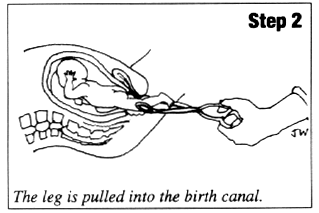D&X:

Grim technology for Abortion's Older Victims
by Jenny Westberg
 Dallas, TX—A grisly new second and third-trimester abortion procedure was revealed at the National Abortion Federation (NAF) Risk Management Seminar, September 13-14, 1992, in Dallas. Dr. Martin Haskell, a Cincinnati abortionist, presented a scientific paper describing the procedure. Dallas, TX—A grisly new second and third-trimester abortion procedure was revealed at the National Abortion Federation (NAF) Risk Management Seminar, September 13-14, 1992, in Dallas. Dr. Martin Haskell, a Cincinnati abortionist, presented a scientific paper describing the procedure.
The new procedure is called "dilation and extraction." Haskell has coined the term "D&X" For the method, in order to distinguish it from the standard D&E method. "D&E" stands for dilation and evacuation.
D&X differs from D&E in that the unborn child is removed intact, rather than being dismembered inside the uterus. The child is killed by suctioning the brain tissue through a hole in the base of the skull, which the abortionist makes with blunt surgical scissors. This is accomplished while the living child's head is still inside the uterus, after pulling the baby's body out, feet first and kicking, into the birth canal. 
Haskell recommends the D&X procedure for late second-trimester and third-trimester abortions. Classic D&E presents technical problems in late pregnancy because of the "toughness of fetal tissues at this stage of development." Accordingly, most late abortions have traditionally been performed by instillation methods, such as saline and prostaglandin. However, these methods are risky for the mother; moreover, no traditional instillation method entirely guarantees the death of the baby, which, to abortionists, is a serious drawback.
Since D&X avoids the problems attendant to late-term dismemberment, it can be employed throughout the second and third trimesters.
While Haskell has only utilized D&X through 26 weeks' gestation, he cites another physician's experience as evidence that D&X can be used to perform third-trimester abortions. Dr. James McMahon, of McMahon Medical Center and Eve Surgical Centers in Los Angeles and Tarzana, California, uses D&X to abort children up to 32 weeks "or more," according to Haskell.
In order to use D&X in the third trimester, only a few modifications are necessary, including additional cervical dilation and a slower operating time.
Haskell says he has performed over 700 D&X abortions.
 The D&X is so similar to infanticide, that when a college student observed Haskell perform a D&X abortion in 1989, her reaction was to call the police. (See Life Advocate, January 1993, "Dismemberment and Choice," page 36.) The D&X is so similar to infanticide, that when a college student observed Haskell perform a D&X abortion in 1989, her reaction was to call the police. (See Life Advocate, January 1993, "Dismemberment and Choice," page 36.)
According to Haskell's protocol, the D&X procedure begins with "dilation [and] MORE DILATION." The cervix is initially dilated to 911 mm. with mechanical dilators, in order to accommodate the placement of five to seven large Dilapan hydroscopic dilators (synthetic laminaria), which remain in place overnight.
The following morning, the Dilapan are removed and replaced with a second insertion of 15 to 25 Dilapan. Once again, these are left in place overnight.
The Dilapan dilation process may cause severe cramping, which is treated with pain relievers when necessary.
The operation itself takes place on Day 3. After removing the Dilapan, the abortionist ruptures the membranes (if the patient's water has not already broken) and drains the amniotic fluid.
The abortionist's assistant places an ultrasound transducer on the mother's abdomen and locates the child's legs and feet. 
The abortionist then uses a large forceps to grasp one of the baby's legs. He pulls firmly, forcing the child into a feet-down position. He continues pulling until the baby's leg is drawn into the birth canal.
Next, using his hands instead of forceps, the abortionist delivers the baby's body in a manner similar to vaginal breech birth. First the child's other leg is delivered, followed by the torso shoulders, and arms. The baby's head "usually" remains inside the uterus, too large to pass through the internal cervical os.
The abortionist then performs the next step (which Haskell euphemistically calls "fetal skull decompression"). Using blunt-tipped surgical scissors in a closed position, he pierces the child ' s head at the base of the skull. He then forces the scissors open, enlarging the wound. Removing the scissors, the abortionist inserts a suction catheter into the wound and vacuums out the child's brain tissue(or, as Haskell puts it, "evacuates the skull contents"). With the suction tube still in place, the abortionist then pulls the corpse from the woman's body. He delivers the placenta with forceps, and scrapes the inside of the uterus with a sharp curette, then with a largebore suction curette.
According to Haskell, the woman usually recovers quickly: on her feet in 30 minutes; out the door in two hours. Haskell claims a "low rate" of complications, although he does not provide specific numbers.
 The Dallas conference, at which Haskell described the D&X technique, was entitled "Second Trimester Abortion: From Every Angle." Haskell's presentation included a 10-minute video of an actual D&X. The Dallas conference, at which Haskell described the D&X technique, was entitled "Second Trimester Abortion: From Every Angle." Haskell's presentation included a 10-minute video of an actual D&X.
The next NAF conference is scheduled for April 24-27} 1993, in Washington, D.C.
(Note: Except where otherwise indicated, all quotes in this article are from "Dilation and Extraction for Late Second Trimester Abortion," by Martin Haskell, M.D. See sidebar, page 5, for full reference.)

© 1997 Advocates for Life Ministries

|
